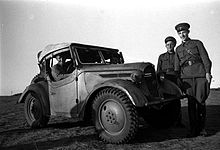Type 95 reconnaissance vehicle
The Type 95 reconnaissance vehicle ( Japanese 九五 式 装甲 軌道 車 Kyūgo-shiki kogata jōyōsha ) Kurogane was a Japanese off-road vehicle from Nippon Internal Combustion Engine Company . The car was mostly referred to by the Japanese soldiers only with its nickname " Daruma ". It is comparable to the American jeeps . The Type 95 remained the only original Japanese off-road vehicle until the end of the war in 1945. All other vehicles in this category were copied variants of foreign, primarily US-American products.
conditions
Based on the experience gained in Manchuria and northern China at the beginning of the 1930s, the automobile manufacturer Nippon Nainenki Seiko Co. in Tokyo developed a type of “Jeep”. The harsh Manchurian climate in connection with a traffic-technically unfavorable terrain had shown the Japanese army that such a vehicle was needed.
technology
A technically complex and difficult to maintain all-wheel drive with independent suspension and coil springs gave the vehicle good off-road mobility, which was limited by an air-cooled two-cylinder petroleum engine that was too weak with 33 hp. The brakes, which only acted on the rear wheels, were another disadvantage in the field.
variants
Originally only two men were planned as a crew, but a third seat was soon installed. Although Nippon Nainenki Seiko already delivered different versions from the factory, such as a pick-up or a limousine, the wildest variants and improvisations gradually emerged on the front lines, depending on requirements and depending on the spare parts situation, which deteriorated drastically in the course of the war.
commitment
The 4,775 vehicles built were mostly used in rear supply units as connecting vehicles or, depending on the model, as trucks. With heavily profiled tires, the "Daruma" was able to cope with difficult terrain and thus also serve as a reconnaissance vehicle. During his mission he fulfilled the hopes of the soldiers for an all-terrain vehicle, as he was able to cope with the poor Chinese road conditions and then - in the course of the Pacific War - with the conditions on the conquered islands and in Burma, even when it was extremely cold. During the operations in northern China and Manchuria, the engine proved to be ideal, as it could cope with low temperatures and, due to the air cooling, did not rely on the little clean water in these regions. The main disadvantage was the high maintenance requirements.
Technical data (off-road vehicle version)
- Length: 338 cm
- Width: 152 cm
- Height: 168 cm
- Chassis: 4x4
- Total weight: 1100 kg
- Crew: one driver, one passenger, in the later version up to three passengers
- Motorization: a two-cylinder Kurogane V1-AF with 33 HP (24.6 kW), air-cooled
- Displacement: 1399 cm³
- Tank volume: 48.83 liters
- Fuel: petroleum
- Transmission: three forward gears, one reverse gear
- Top speed: 75 km / h
- Consumption: one liter per 13.18 km
- Driving range: 450 km
- Ford depth: 0.5 m
Others
- Producer: Nippon Nainenki Seizō (Kurogane)
- Production: 1935–1945 (all versions)
- Vehicles produced: 4,755 pieces (all versions)
literature
- Philip Trewhitt: tanks. Neuer Kaiserverlag, Klagenfurt 2005, ISBN 3-7043-3197-X , p. 152.

